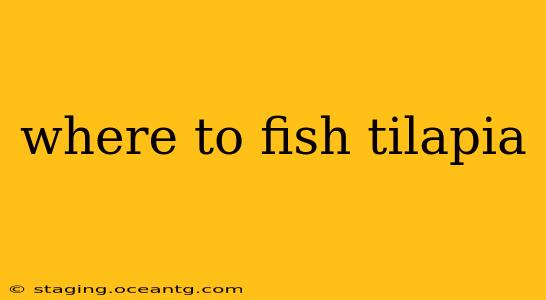Tilapia, a delicious and widely farmed fish, is also found in various wild habitats. Knowing where to find them requires understanding their preferred environments. This guide will help you locate wild tilapia, covering ideal habitats, popular fishing spots, and crucial tips for a successful fishing trip.
What kind of waters do Tilapia prefer?
Tilapia thrive in warm, freshwater environments. They are incredibly adaptable, but certain conditions are key to their survival and thus, where you'll find them fishing. Look for:
- Warm Water: Tilapia are tropical and subtropical fish, preferring water temperatures between 68°F and 86°F (20°C and 30°C). Colder waters will significantly reduce their activity and make them harder to catch.
- Still or Slow-Moving Water: While they can tolerate some current, tilapia generally prefer lakes, ponds, reservoirs, and slow-moving rivers with plenty of vegetation. They're not typically found in fast-flowing streams or rapids.
- Abundant Vegetation: Tilapia often seek shelter and food among aquatic plants, submerged logs, and other structures. Areas with dense vegetation are prime fishing spots.
- Clear or Slightly Murky Water: While they can tolerate some turbidity, excessively muddy water can hinder their ability to feed and find mates.
What are some popular fishing spots for Tilapia?
Pinpointing specific locations is tricky due to varying environmental conditions and regulations. However, some general areas are known for good tilapia fishing:
- Reservoirs and Lakes: Many reservoirs and lakes, especially those in warmer climates, support thriving tilapia populations. Check local fishing regulations and explore areas with calm bays, inlets, and weed beds.
- Canals and Irrigation Ditches: In agricultural areas, canals and irrigation ditches often provide suitable habitats for tilapia, particularly if the water is warm and there's sufficient vegetation.
- Farm Ponds: While often privately owned, some farm ponds may be open to fishing with permission from the landowner. These ponds often offer high tilapia densities.
What bait and tackle should I use for Tilapia?
Choosing the right bait and tackle is crucial for a successful fishing trip. Tilapia are opportunistic feeders, so a variety of options can work. Consider these:
- Bait: Bread, dough balls, corn, worms, and small insects are all effective baits. Experiment to see what works best in your specific location.
- Tackle: Light to medium-light tackle is ideal. A spinning rod and reel with 6-8lb test line is a great starting point. Small hooks (size 6-8) are recommended to avoid damaging the fish's mouth.
What time of year is best for Tilapia fishing?
The best time to fish for tilapia generally coincides with warmer months when water temperatures are optimal. This typically falls between spring and fall in most regions. However, this can vary depending on geographical location and specific water bodies.
Are there any size and bag limits for Tilapia?
Absolutely! Fishing regulations vary greatly depending on location. Always check with your local fisheries department or wildlife agency for specific size and bag limits, licensing requirements, and any other pertinent regulations before you go fishing. Ignoring these rules can lead to fines.
What are some tips for successful Tilapia fishing?
- Patience is key: Tilapia can be finicky at times, so patience is essential.
- Observe the water: Look for signs of tilapia activity, such as surface disturbances or fish jumping.
- Use stealth: Approach your fishing spot quietly and avoid making sudden movements to avoid spooking the fish.
- Experiment with different baits and techniques: What works well in one location may not work in another.
- Practice catch and release: To help maintain healthy tilapia populations, consider practicing catch and release, especially with smaller fish.
Remember, responsible fishing practices are crucial for preserving tilapia populations and ensuring the sustainability of this valuable resource. Always respect local regulations, and enjoy your fishing trip!
